The Sandomierzacy are a ethnographic group of the Polish nation, who reside in the historic province of Lesser Poland, around the town of Sandomierz. They use their own dialect, which belongs to Lesser Polish dialect of the Polish language. Like most Poles, the Sandomierzacy are Roman Catholics.
The Sandomierzacy proper reside along the left bank of the Vistula river, reaching Ilza and Skaryszew in the north, and Checiny in the west. They also live southeast of Sandomierz, in former Austrian Galicia. Together with the Krakowiacy, the Sandomierzacy are the oldest ethnic group of Lesser Poland. In the 19th century, when Lesser Poland was for over 100 years divided between the Habsburg Empire and the Russian Empire, the Sandomierzacy were under the influence of Mazovia, which resulted in several changes, mostly in their traditional clothing.
The Borowiacy sandomierscy is a small subethnic group of Sandomierzacy, which resides along right bank of the San river, in forested areas of Janow Lubelski.
The Posaniacy is another subethnicy group of the Sandomierzacy. They inhabited the Sandomierz Forest, and in the 19th century, most of them settled in forests around Radom.

Lesser Poland, often known by its Polish name Małopolska, is a historical region situated in southern and south-eastern Poland. Its capital and largest city is Kraków. Throughout centuries, Lesser Poland developed a separate culture featuring diverse architecture, folk costumes, dances, cuisine, traditions and a rare Lesser Polish dialect. The region is rich in historical landmarks, monuments, castles, natural scenery and UNESCO World Heritage Sites.
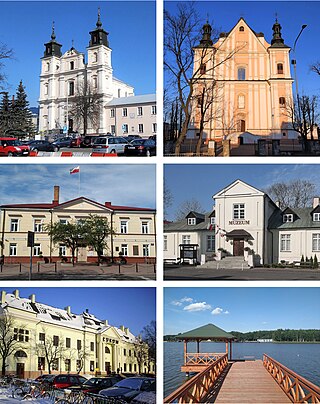
Łuków is a city in eastern Poland with 30,727 inhabitants. Since 1999, it has been situated in the Lublin Voivodeship, previously it had belonged to the Siedlce Voivodeship. It is the capital of Łuków County.

Sandomierz is a historic town in south-eastern Poland with 23,863 inhabitants, situated on the Vistula River near its confluence with the San, in the Sandomierz Basin. It has been part of Świętokrzyskie Voivodeship since its transfer from the Tarnobrzeg Voivodeship in 1999. It is the capital of Sandomierz County. Sandomierz is known for its preserved Old Town, a major cultural and tourist attraction which the President of Poland declared a National Monument of Poland in 2017.

Tarnobrzeg is a city in south-eastern Poland, on the east bank of the river Vistula, with 49,419 inhabitants, as of 31 December 2009. Situated in the Subcarpathian Voivodeship since 1999, it had previously been the capital of Tarnobrzeg Voivodeship (1975–1998). Tarnobrzeg lies in the Sandomierz Basin, and directly borders the town of Sandomierz, Świętokrzyskie Voivodeship. Its history dates back to the year 1593, when it was granted Magdeburg rights, and belonged to the Tarnowski family. For centuries Tarnobrzeg remained a small town, which did not develop until the post-World War II period, when it became center of an industrial area, based on rich sulfur deposits.
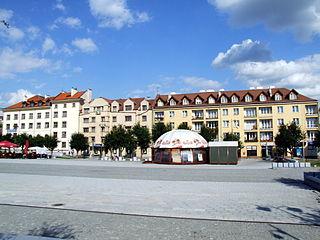
Ostrowiec Świętokrzyski, often referred to as Ostrowiec, is a city in southeastern Poland, in the historical region of Lesser Poland, with 66,258 residents. The town is one of the historic centers of Polish industry and metallurgy, and was part of the Old-Polish Industrial Region, the oldest industrial basin of the country.
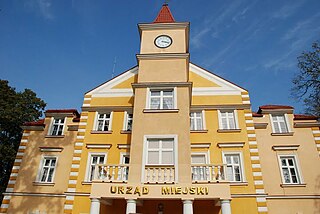
Dębica is a town in southeastern Poland with 44,692 inhabitants as of December 2021. It is the capital of Dębica County. Since 1999 it has been situated in the Podkarpackie Voivodeship; it had previously been in the Tarnów Voivodeship (1975–1998). Dębica belongs to the historic province of Lesser Poland, and for centuries it was part of the Sandomierz Voivodeship.

Sandomierz Voivodeship was a unit of administration and local government in Poland from the 14th century to the partitions of Poland in 1772–1795. It was part of the Lesser Poland region and the Lesser Poland Province. Originally Sandomierz Voivodeship also covered the area around Lublin, but in 1474 its three eastern counties were organized into Lublin Voivodeship. In the 16th century, it had 374 parishes, 100 towns and 2586 villages. The voivodeship was based on the Sandomerz ziemia, which earlier was the Duchy of Sandomierz. The Duchy of Sandomierz was created in 1138 by King Bolesław III Wrymouth, who in his testament divided Poland into five principalities. One of them, with the capital at Sandomierz, was assigned to Krzywousty's son, Henry of Sandomierz. Later on, with southern part of the Seniorate Province, the Duchy of Sandomierz created Lesser Poland, divided into Kraków and Sandomierz Voivodeships.

Nowy Korczyn is a small town in Busko County, Świętokrzyskie Voivodeship, in south-central Poland. It is the seat of the gmina called Gmina Nowy Korczyn. It lies in Lesser Poland, approximately 20 kilometres (12 mi) south of Busko-Zdrój and 67 km (42 mi) south of the regional capital Kielce. It is located close to the confluence of the Nida and the Vistula rivers. Nowy Korczyn was a town from 1258 to 1869.
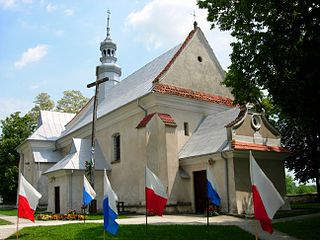
Zawichost is a small town in Sandomierz County, Świętokrzyskie Voivodeship, Poland. It is located by the Vistula River in Lesser Poland, near Sandomierz. It is first mentioned in historical documents from around 1148. In 1205 the Battle of Zawichost was fought nearby. In 1241, 1259 and 1287 the town was ravaged by Mongol raids. Granted town rights before 1255, in the late Middle Ages it was one of the most important urban centers of Lesser Poland.

The Dąbrowa Basin or Zagłębie Dąbrowskie is a geographical and historical region in southern Poland. It forms western part of Lesser Poland, though it shares some cultural and historical features with the neighbouring Upper Silesia. The region is sometimes referred to in English as Zaglembie or Zaglembia, especially in Jewish publications written in the English language.

Staszów is a town in southeastern Poland, in Świętokrzyskie Voivodeship, about 54 kilometres southeast of Kielce, and 120 km (75 mi) northeast of Kraków. It is the capital of Staszów County. The population is 15,108 (2010), which makes it the 8th largest urban center of the province. The area of the town is 26,88 km2, and its two rivers are the Desta and the Czarna Staszowska.

Pilzno is a town in Poland, in Subcarpathian Voivodeship, in Dębica County. It has 4,943 inhabitants as of 2018. It is located at the junction of important road of the Polish national road network DK 93 and DK 73 but has no railroad, even though in 1939 Polish government began construction of the Dębica – Jasło line, via Pilzno. The project was never completed.

Wojnicz is an ancient historic town in Tarnów County, Lesser Poland Voivodeship. In the early medieval period of the Polish state, it became one of the most important centres in the province of Lesser Poland, as part of the system of Dunajec river castles. It became the seat of a Castellan and prospered from the 13th century to the first half of the 17th century, being on an international trade route bordering Hungary and the Ottoman Empire. It had town and market rights, its church was raised to collegiate status with links to the Jagiellonian University in Kraków 64 km away.

Stopnica is a town in Busko County, Świętokrzyskie Voivodeship, in south-central Poland. It is the seat of the gmina called Gmina Stopnica. It lies in Lesser Poland, approximately 17 kilometres (11 mi) east of Busko-Zdrój and 55 km (34 mi) south-east of the regional capital Kielce.
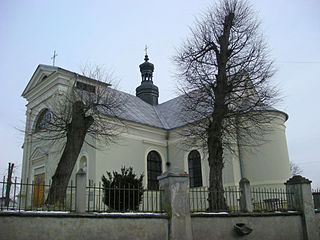
Osiek is a town in Staszów County, Świętokrzyskie Voivodeship, Poland, with 2,001 inhabitants (2010). The town lies in Lesser Poland, along the National Road nr. 79, which goes from Warsaw to Bytom. Osiek is located 15 kilometers northeast of Połaniec, and 18 kilometers west of Tarnobrzeg, 180 meters above sea level.

Rudnik nad Sanem is a town in Nisko County, Subcarpathian Voivodeship, Poland, with a population of 6,765 (02.06.2009). The town is located next to the river San, hence the "nad Sanem" part of the name, which was appended to the official name in 1997. It is 4 miles (6.4 km) south-west of Ulanów and 29 miles (47 km) north-east of Rzeszów. Rudnik prides itself as the Polish Capital of Wicker.

Przedbórz is a town in Radomsko County, Łódź Voivodeship, Poland, with 3,458 inhabitants (2020). Przedbórz is situated on the Pilica River in the northwestern corner of the historic province of Lesser Poland. From its foundation until the Partitions of Poland, it belonged to Lesser Poland’s Sandomierz Voivodeship.

Sandomierz Forest is one of the biggest forests in southern Poland; covering large parts of the Sandomierz Basin. Its name comes from the historical city of Sandomierz, and in the Middle Ages its eastern edge created a natural border between Lesser Poland and Red Ruthenia.
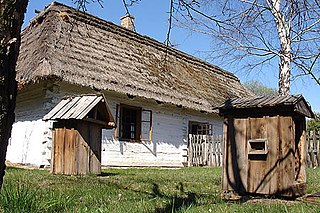
Lasovians are a subethnic group of the Polish nation, who reside in Lesser Poland, at the confluence of the Vistula and the San rivers, Subcarpathian Voivodeship, southeastern Poland. They are descended from various ethnic groups, which settled in the dense Sandomierz Forest across centuries, with a dominant Polish element. The Lasowiacy were formed as a separate subethnic group in the late 19th and early 20th century. They use their own dialect, which belongs to Lesser Polish dialect cluster of the Polish language. Like most Poles, the Lasowiacy are Roman Catholics.
The Lublinians are a subethnic group of the Polish people, who reside in the historic region of Lesser Poland, in the area of the city of Lublin. They use their own dialect, which belongs to the Lesser Poland dialect of the Polish language. Like most Poles, the Lubliniacy are Roman Catholics.